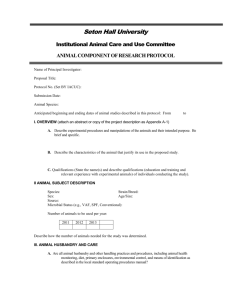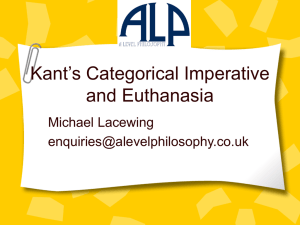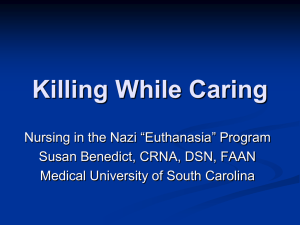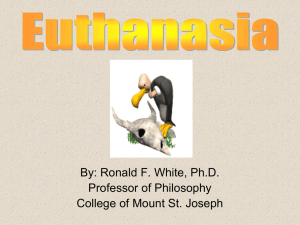Euthanasia Policy - UCSF Animal Care and Use Program
advertisement
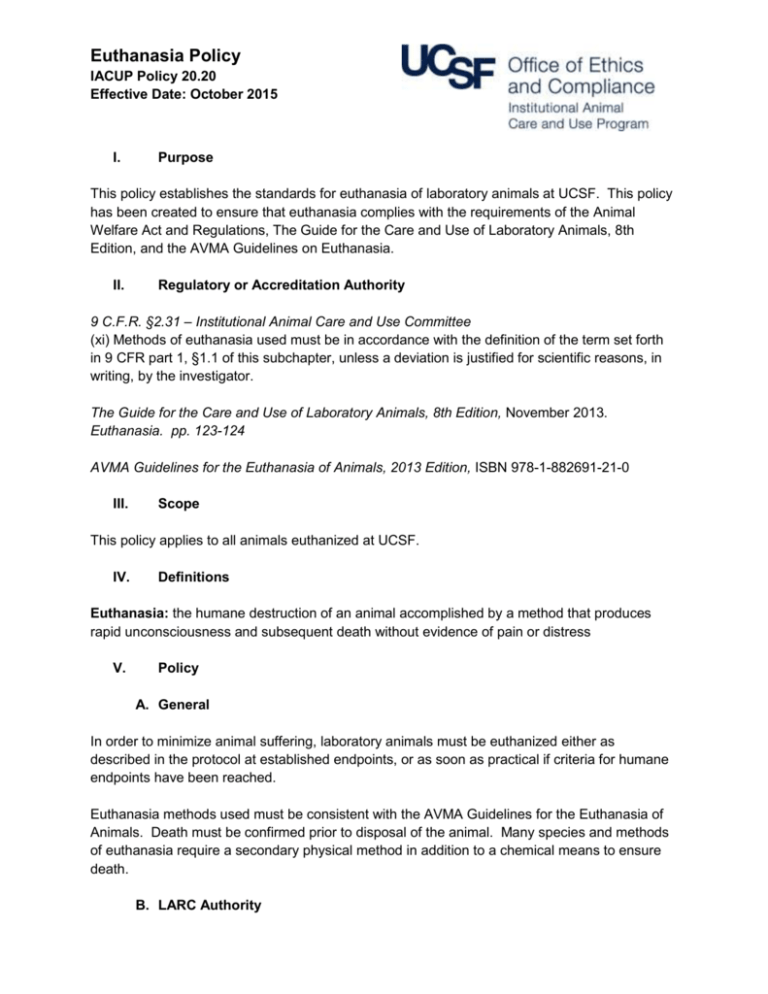
Euthanasia Policy IACUP Policy 20.20 Effective Date: October 2015 I. Purpose This policy establishes the standards for euthanasia of laboratory animals at UCSF. This policy has been created to ensure that euthanasia complies with the requirements of the Animal Welfare Act and Regulations, The Guide for the Care and Use of Laboratory Animals, 8th Edition, and the AVMA Guidelines on Euthanasia. II. Regulatory or Accreditation Authority 9 C.F.R. §2.31 – Institutional Animal Care and Use Committee (xi) Methods of euthanasia used must be in accordance with the definition of the term set forth in 9 CFR part 1, §1.1 of this subchapter, unless a deviation is justified for scientific reasons, in writing, by the investigator. The Guide for the Care and Use of Laboratory Animals, 8th Edition, November 2013. Euthanasia. pp. 123-124 AVMA Guidelines for the Euthanasia of Animals, 2013 Edition, ISBN 978-1-882691-21-0 III. Scope This policy applies to all animals euthanized at UCSF. IV. Definitions Euthanasia: the humane destruction of an animal accomplished by a method that produces rapid unconsciousness and subsequent death without evidence of pain or distress V. Policy A. General In order to minimize animal suffering, laboratory animals must be euthanized either as described in the protocol at established endpoints, or as soon as practical if criteria for humane endpoints have been reached. Euthanasia methods used must be consistent with the AVMA Guidelines for the Euthanasia of Animals. Death must be confirmed prior to disposal of the animal. Many species and methods of euthanasia require a secondary physical method in addition to a chemical means to ensure death. B. LARC Authority In the event that LARC facility staff discover animals suffering from unrelieved pain or distress, or are discovered near death, LARC facility staff will attempt to contact the PI or designated alternate. If the PI or alternate cannot be reached, euthanasia may be administered at the discretion of LARC veterinary staff. C. Protocol Requirements Protocols must include a description of methods used for euthanasia, as well as a description of how death will be confirmed. IACUC Appendices for Euthanasia Appendices are provided as IACUC suggestions or recommendations. Deviation from the attached appendices may require IACUC approval. Appendix A: Rodent Euthanasia IACUC Approved: October 2013 Use of an anesthetic agent for euthanasia must be administered at an overdose, not an anesthetic dose. To confirm death, any chemical method used for euthanasia must be followed by a physical method from which the animal cannot recover, such as decapitation, exsanguination, cervical dislocation, bilateral thoracotomy, tissue perfusion, or dissecting of a major organ. The animal must be completely non-responsive to noxious stimuli (hind foot pad pinch on each foot) before any physical method is performed. All agents used are to be pharmaceutical grade. The techniques listed below are methods commonly approved in UCSF IACUC protocols for the euthanasia of rodents. Other methods outlined in the AVMA Guidelines on Euthanasia are acceptable when approved in the IACUC protocol. Chemical Methods: Carbon Dioxide Inhalation/administration: CO2 is delivered from a pressurized tank into an un-crowded cage to ensure precise regulation of gas inflow. The flow rate must be set to displace 10-30% of the chamber or cage volume/minute, allowing CO2 to enter the chamber slowly so that unconsciousness and complete narcotization occur prior to death. Prefilled chambers are unacceptable. CO2 flow should be maintained for at least one minute after respiratory arrest; animals must be left in the chamber for a sufficient time so that death has occurred prior to performing a physical method. When euthanizing mice, a standard size mouse cage may contain no more than 2 litters. To ensure compliance with the AVMA Guidelines, a precision CO2 gauge/regulator with a pressure reducing valve or flow meter must be used. Units in centralized care (LARC) are equipped with precision preset flow restriction valves. Units in decentralized care must be similarly equipped or a flow meter may be used that is set to the proper flow rate for the size of cage utilized. See table below. Inspection and verification of flow rate that is in compliance with the AVMA Guidelines should be confirmed on an annual basis by the lab. Cage Type Mouse Rat Cage Size Supermouse750 (0.263 ft3) Onecage2100 (0.970 ft3) CO2 Flow Rate 2 L/min 8 L/min When possible, euthanize rodents in their home cage to minimize the stress of being placed into an unfamiliar enclosure and to prevent social aggression. Cages/containers used for euthanasia must allow clear visibility, be a size that permits full posture to be expressed, and be disinfected between uses to remove the potential distress that may be caused by exposure to remaining pheromones. Injectable Anesthetic Overdose: Intraperitoneal injection of at least 200 mg/kg sodium pentobarbital is recommended; other injectable anesthetics may be approved and delivered at an overdose. Pentobarbital solutions can be viscous and are best diluted to a concentration of no more than 60 mg/ml. Intracardiac injections are suitable only if the animal is adequately anesthetized. Inhalant Anesthetic Overdose: Isoflurane inhalation at an overdose may be utilized as a method of euthanasia, either by precision vaporizer or open-drop method. If open-drop isoflurane is utilized, it must be adequately scavenged to prevent personnel exposure. Animals may need to be exposed for prolonged time periods to ensure death. Euthanasia while under anesthesia: When animals are fully anesthetized as at the end of a non-survival surgery, methods such as bilateral thoracotomy, exsanguination or perfusion are acceptable. Temporary Holding Cages: On occasion, it may be useful for investigators to temporarily hold more than 5 mice per cage. For example: mice being collected for immediate euthanasia. This is acceptable as long as the following conditions are met: • • • • Up to 10 compatible mice may be placed in a temporary holding cage for up to 30 minute and holding cages are never left unattended. If fighting is observed, mice must be immediately separated. Adult males ≥ 6 weeks old from different cages should not be combined For mice and rat pups < 7 days old, refer to the below guidance Physical Methods: Chemical methods must be followed by decapitation, exsanguination, cervical dislocation, bilateral thoracotomy, tissue perfusion, or dissecting of a major organ, and after the animal has been determined to be non-responsive to noxious stimuli. Physical methods of euthanasia such as decapitation or cervical dislocation of unanesthetized animals may be approved by the IACUC with appropriate justification in the IACUC protocol. The PI must ensure that personnel are experienced or properly trained. Demonstration of competence is required. To schedule an appointment to demonstrate competency please contact trainerIACUC@ucsf.edu. Rats and Hamsters: Cervical dislocation may be acceptable if performed on animals less than 21 days and/or weighing less than 200 grams. Guinea pigs: Cervical dislocation may not be performed on guinea pigs. Fetuses and Neonates • It is not necessary to remove fetuses for euthanasia after the dam is euthanized as they are unconscious in utero and hypoxia does not evoke a response. Appendix B: Non-Rodent Mammal Euthanasia IACUC Approved: [Approval Date] Use of an anesthetic agent for euthanasia must be at an overdose, not an anesthetic dose. To confirm death, the administration of any chemical agent used for euthanasia must be followed by a physical method from which the animal cannot recover, such as bilateral thoracotomy or fixative perfusion. The animal must be completely non-responsive to noxious stimuli before any physical method is performed. All agents used are to be pharmaceutical grade. The techniques listed below are methods commonly approved by the UCSF IACUC for the euthanasia of non-rodent animals. Appropriate restraint for the species must always be applied. Sedation, anesthesia, or tranquilization may be necessary for some species or individual animals prior to the administration of the euthanasia agent(s). Techniques: Injectable anesthetic overdose: Intravenous injection of an anesthetic agent may be an acceptable method; however, intracardiac injections are acceptable only if the animal is adequately anesthetized. Intraperitoneal injection may be approved for smaller species. Sodium pentobarbital is the recommended anesthetic agent for animal euthanasia, though some other injectable anesthetics may be acceptable. Euthanasia while under anesthesia: when animals are fully anesthetized, as at the end of non-survival surgery, methods such as bilateral thoracotomy, exsanguination, perfusion, or intravenous or intracardiac injection of potassium chloride are acceptable. Use of these techniques must be specifically described in the IACUC protocol, or as prescribed by a LARC veterinarian in case of clinical emergencies. Disposal: UCSF policy is to treat ALL animal carcasses as infected biohazardous waste and to discard them in red biohazard bags. The bags must be sealed and stored in waterproof containers with tight-fitting lids in designated cold rooms or freezers until removed by the animal waste management contractors; these containers should not weigh more than 50 pounds when filled. Carcasses weighing more than 50 pounds should be disposed of one per container; contact the Laboratory Animal Resource Center (LARC) at 476-2204 to make arrangements to dispose of carcasses totaling more than 50 pounds or for further information regarding disposal Training: Only trained individuals may perform euthanasia. Training is provided in individual or group workshops through IACUC Training and Compliance, trainerIACUC@ucsf.edu Appendix C: Zebrafish Euthanasia IACUC Approved: June 2015 Approved methods for adult zebrafish 7 days post fertilization (dpf) and older include: Tricaine (MS-222): Immerse fish in a solution of tricaine methanesulfonate (Finquel or Tricaine-S). The solution should be buffered with sodium bicarbonate to a pH of 7.0-7.5. Stock preparation is 4g/L buffered to pH7 in sodium bicarbonate (at 2:1 bicarb to MS222). Euthanasia dosage 300ug/ml or 7.5ml stock solution to a total of 100ml. Fish must remain in the solution for 10 minutes following cessation of opercular (gill) movement. Rapid chilling: Submerge fish in 0-4⁰ C chilled water (5 parts ice to 1 part water ) Fish should not be in direct contact with ice. Fish must remain in the chilled water for 10 minutes following cessation of opercular movement. Zebrafish fry 4-7 days post fertilization: Tricaine or rapid chilling may be used as above, but fry should remain submerged in solution for 20 minutes following cessation of opercular movement Zebrafish embryos 0-3 days post fertilization: Add dilute bleach solution (1 part sodium hypochlorite 6.15% to 5 parts water) to the water for 5 minutes to ensure embryonic lethality. Tricaine and rapid chilling are unreliable methods of euthanasia for embryos <3 dpf. After one of the above methods has been performed, acceptable adjunctive physical methods for all stages of development will be done including maceration (for non-transgenic animals) or placement of the animal carcasses in the freezer. Carcasses will be transferred to biohazard bags at -20C for a minimum of 24 hours and subsequently disposed of as potentially hazardous tissue by LARC. References: American Veterinary Medical Association. 2013. AVMA guidelines on euthanasia, 2013 update. Koerber AS and Kalishman J. 2009. Preparing for a Semiannual IACUC Inspection of a Satellite Zebrafish (Danio rerio) Facility. Journal of the American Association for Laboratory Animal Science. 48: 65-75. NIH. 2009. Guidelines for Use of Zebrafish in the NIH Intramural Research Program.

